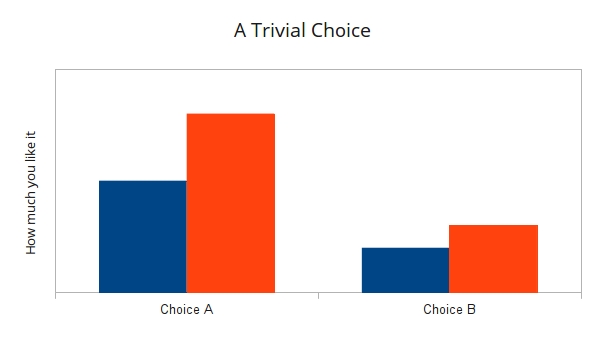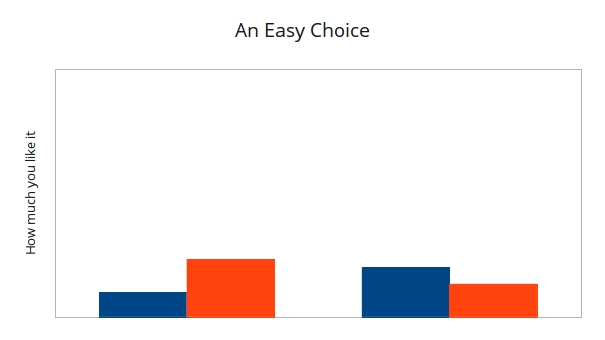Choose easier by visualizing choices, part 2
Multiple factors
Not all options have only one decision factor. Many have two or more. For example, do you prefer a job with higher pay but lower chance of promotion or higher chance of promotion but lower pay?
You have to look case-by-case, but let’s see how our visual representation shows them.
A trivial choice
The easiest two-part case is when you prefer both parts of an option to both parts of the other. Consider if you had to choose between
- A high-paying job with great benefits and
- A low-paying job with no benefits.
This graph illustrates such a choice. All else being equal, you’d choose the first option.
Again, this illustration is simple, but we’re just seeing how the visual model works with two options.
A more challenging but still easy choice
In general, you won’t prefer all parts of a choice more. Often your preferences between options will vary.
An easy case there would be where you prefer one part of B a little and the other part of A a lot. Consider if you had to choose between
- A vacation at an affordable price to a place you’ve always dreamed of visiting and
- A vacation at a slightly cheaper price to a place you aren’t that interested in visiting.
You prefer the lower price of the second option, but not nearly as much as you prefer the dream location. We represent the choice as follows.
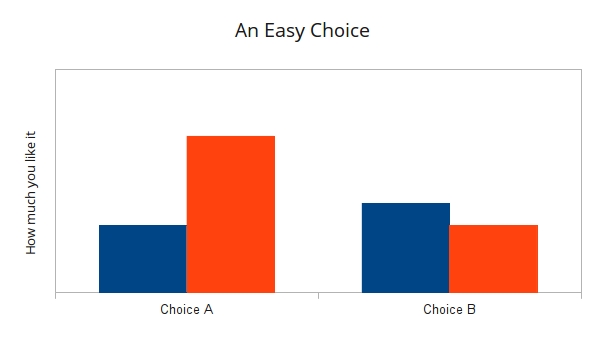 You could simplify thinking of your choice by thinking of adding the total value of the parts of each choice separately and comparing those totals. The better you know how much you value each part the better you can add and compare. The worse you know your values, the harder time you’ll have comparing them.
You could simplify thinking of your choice by thinking of adding the total value of the parts of each choice separately and comparing those totals. The better you know how much you value each part the better you can add and compare. The worse you know your values, the harder time you’ll have comparing them.
Aren’t we adding apples and oranges by adding price to location? No, we aren’t adding the options. We’re adding the value of the options to us. The value isn’t money, location, or anything external. The value comes from the feelings those things will be. You don’t have to rely on anyone else to know what your feelings mean to you. That’s the value of emotional intelligence and self-awareness — they mean you understand what things mean to you.
A harder, more complicated choice
Once you have multiple options, the choices can become much harder than two-option choices. You might strongly prefer one part of one option and slightly prefer the other so that the total values of each option are nearly equal. Such choices can be hard. Consider, for example, choosing between
- A restaurant you can barely afford with incredible food and
- A cheaper restaurant with passable food
Your options might look like this.
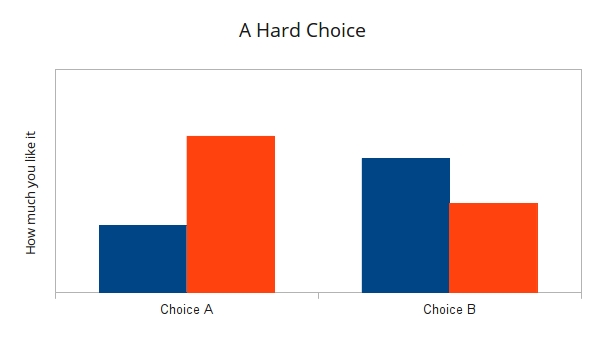 You’ll have a harder time choosing. Not only can you not obviously tell which choice you overall prefer, you have more sub-options to compare.
You’ll have a harder time choosing. Not only can you not obviously tell which choice you overall prefer, you have more sub-options to compare.
At times like that, yesterday’s lesson — try to make the stakes of choosing less important — helps again. That is, try to make the same choice feel like this:
In this graph, I made the relative values of each choice and sub-choice equal, but the total values smaller. You can always do this by changing your beliefs. Some people go crazy trying to choose. It wouldn’t surprise me if marriages have ended over two people with different values and low self-awarenesses unable to resolve the stress of two people each with four preferences unable to decide if it kept happening for years for different choices — restaurants, movies, vacation spots, etc.
Life-level challenges
Such problems compound if neither person understands or even tries to understand the other’s preferences or if one tries to impose their values on the other, as might happen between parents and children or managers with people reporting to them. Consider, for example, if one person preferred the cheaper restaurant and felt the other one didn’t understand the value of money. Great social skills and awareness would enable people to mutually understand and discuss values, then to resolve what conflicts arise. Poor social skills and awareness lead to people arguing over external things like money and time without understanding what those things mean to each other and that they might mean different things in different amounts to different people.
In my experience, learning more about meaning, value, importance, and purpose (MVIP) by understanding how things acquire MVIP through my emotions led me to communicate more on meaning and to understand different values than on superficialities like word choice or to presume to impose my values on others. I argue less and reach agreement faster and easier. Using visualizations like in today’s post helps me simplify that understanding.
An apparently hard but actually easy choice
Sometimes you like part of one option much more and part of the other option equally more. Such cases seem challenging, but like a comparable case yesterday, I’ve found an easy solution.
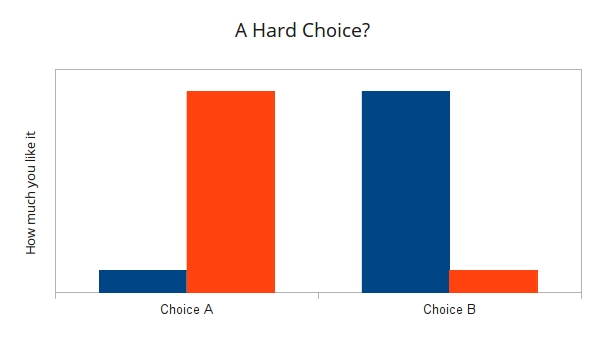 As with yesterday, in such cases, when I can’t find a clear winner I toss a coin. You might argue against using chance to determine what could be an important decision. Doesn’t it devalue the importance of the options? In my experience the process works as well as any other. I didn’t devalue the choices. I simplified the choosing process, and the process is different than the choices themselves.
As with yesterday, in such cases, when I can’t find a clear winner I toss a coin. You might argue against using chance to determine what could be an important decision. Doesn’t it devalue the importance of the options? In my experience the process works as well as any other. I didn’t devalue the choices. I simplified the choosing process, and the process is different than the choices themselves.
Read my weekly newsletter

On initiative, leadership, the environment, and burpees
